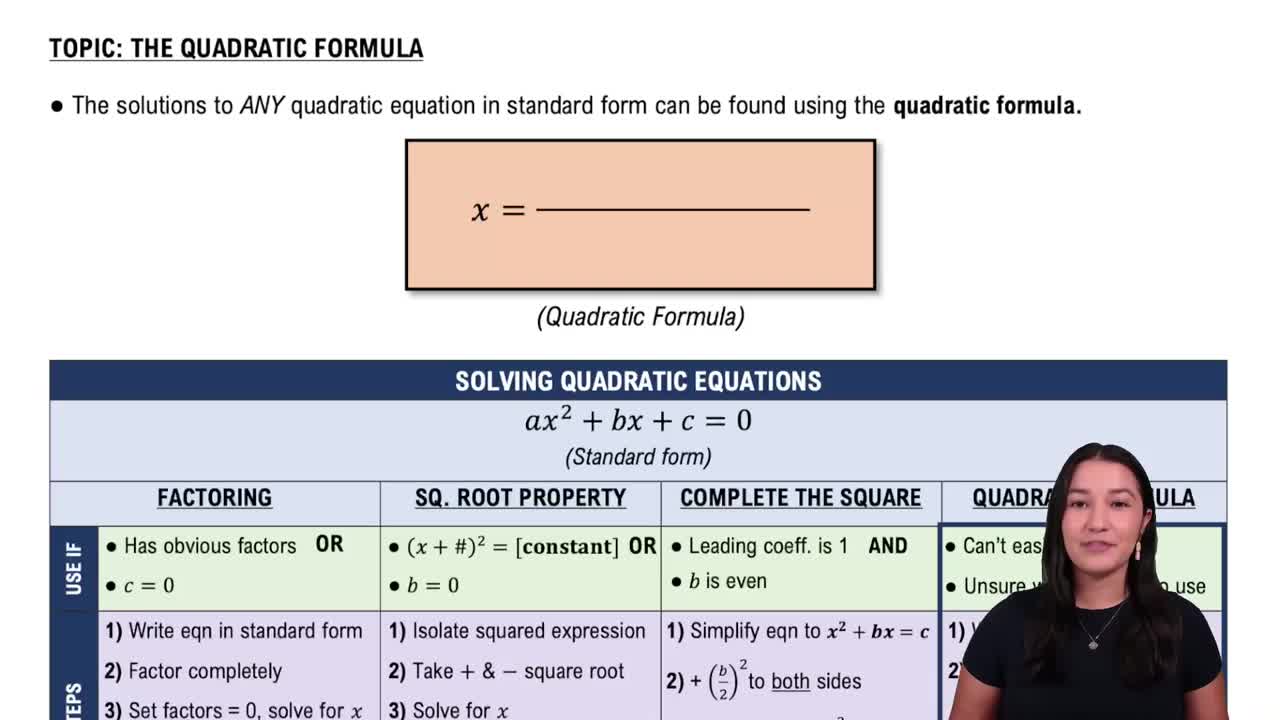Table of contents
- 0. Review of Algebra4h 16m
- 1. Equations & Inequalities3h 18m
- 2. Graphs of Equations43m
- 3. Functions2h 17m
- 4. Polynomial Functions1h 44m
- 5. Rational Functions1h 23m
- 6. Exponential & Logarithmic Functions2h 28m
- 7. Systems of Equations & Matrices4h 6m
- 8. Conic Sections2h 23m
- 9. Sequences, Series, & Induction1h 19m
- 10. Combinatorics & Probability1h 45m
1. Equations & Inequalities
Linear Inequalities
Problem 62c
Textbook Question
In Exercises 61–64, find the domain of each function. f(x) = 1/√(4x^2 - 9x + 2)
 Verified step by step guidance
Verified step by step guidance1
Identify the expression inside the square root, which is 4x^2 - 9x + 2. The domain of the function f(x) will be all values of x for which this expression is non-negative (greater than or equal to zero) because the square root of a negative number is not defined in the set of real numbers.
Set up the inequality 4x^2 - 9x + 2 \geq 0 to find the values of x that make the expression inside the square root non-negative.
Factorize the quadratic expression 4x^2 - 9x + 2 if possible, or use the quadratic formula to find the roots of the equation 4x^2 - 9x + 2 = 0. The roots of this equation will help determine the intervals where the expression is non-negative.
Analyze the sign of the quadratic expression 4x^2 - 9x + 2 in the intervals determined by the roots found in the previous step. This can be done by testing a value from each interval in the original quadratic expression to see if it results in a positive or negative number.
Combine the intervals where the expression 4x^2 - 9x + 2 is non-negative to state the domain of the function f(x).
Recommended similar problem, with video answer:
 Verified Solution
Verified SolutionThis video solution was recommended by our tutors as helpful for the problem above
Video duration:
3mPlay a video:
Was this helpful?
Key Concepts
Here are the essential concepts you must grasp in order to answer the question correctly.
Domain of a Function
The domain of a function refers to the set of all possible input values (x-values) for which the function is defined. For rational and radical functions, the domain is restricted by values that would make the denominator zero or result in taking the square root of a negative number. Understanding the domain is crucial for determining where the function can be evaluated without leading to undefined or non-real results.
Recommended video:

Domain Restrictions of Composed Functions
Quadratic Functions
A quadratic function is a polynomial function of degree two, typically expressed in the form f(x) = ax^2 + bx + c. The expression under the square root in the given function, 4x^2 - 9x + 2, is a quadratic equation. Analyzing the roots and the behavior of this quadratic is essential for identifying the values of x that will keep the function defined, particularly when determining where the expression is positive.
Recommended video:

Solving Quadratic Equations Using The Quadratic Formula
Inequalities
Inequalities are mathematical expressions that show the relationship between two values when they are not equal. In the context of finding the domain of the function f(x) = 1/√(4x^2 - 9x + 2), we need to solve the inequality 4x^2 - 9x + 2 > 0. This involves finding the intervals where the quadratic expression is positive, which is critical for ensuring that the square root is defined and the function remains real-valued.
Recommended video:

Linear Inequalities
Related Videos
Related Practice













